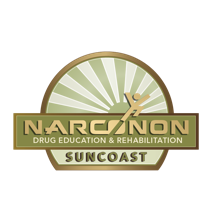All About the Club Drug, “Ecstasy”
Suncoast Rehab has helped many people get off of highly addictive substances like the club drug Ecstasy. There are many drugs qualified as “club drugs”, but ecstasy is possibly the most known. In fact, many other club drugs are referred to in comparison to Ecstasy (like “natural Ecstasy” or “liquid Ecstasy”).
Ecstasy has actually been around as a drug since 1912. I was developed and sold as a diet pill at that time. It was known as “MDMA” and was later rumored to be used in the 50’s for psychological warfare tests. There is no solid proof on this, however. Later, in the 60’s, it resurfaced as a psychotherapy medication used to “lower inhibitions”.
It wasn’t until the 70’s – almost 60 years after it was developed – that Ecstasy began being used as a party drug. Some of the main reasons people took it at that time was to lower inhibitions and create hyper-sensitive touch. It was very popular with those practicing “free love” as this drug is supposed to make the senses of those using it more acute. It can also cause hallucinations.
MDMA (sold as “Ecstasy”) was legal until 1985, when it was banned by the FDA due to safety issues. The main argument used to illegalize this drug was that it creates brain damage , both temporary and permanent. Because it is illegal, ecstasy is currently created in clandestine labs in the US. Ecstasy today is sold on the street.
However, what is sold by dealers as “Ecstasy” can vary in content from actual Ecstasy to LSD, cocaine, GHB (aka “liquid ecstasy” – or “The date rape drug”), heroin, meth, rat poison, dog de-worming medication, etc.
Some of the street names that ecstasy is sold under are: X, XTC, E, Love Drug, Scooby snacks, California Sunshine, Clarity, etc.
With short term use, Ecstasy can cause depression, sleep problems, severe anxiety, paranoia, hallucinations, addiction, muscle tension, involuntary teeth clenching, faintness, etc. In the long term it can cause long-term bran damage, long-term sleep issues, degenerative nerve damage, depression, anxiety, memory loss, kidney failure, psychosis, hemorrhaging, heart problems, convulsions, addiction, and death.
Death from Ecstasy use has become increasingly common in recent years. One of the reasons people who take Ecstasy die is that they are in an impaired state, and they don’t realize how much they are injecting or taking orally. Also, this is an illegal substance, so the drug strength from one hit to another can vary wildly.
Finally, Ecstasy is a slow release, usually with no effect occurring for a solid 20-40 minutes – with full effect not taking place for about 60-90 minutes. What often occurs is the user thinks they aren’t getting high, or the pill was a dud, and they need to take more, with the result of them possibly taking more than their body can handle. The results of these overdoses can be fatal – a horrific occurrence for someone just out for some fun.
If you are addicted to ecstasy or a club drug – or you know someone who is, call Narconon Suncoast today.
Refs: Daily Mail, DrugFreeWorld.org, DanceSafe.org, NIDA, Narconon, DrugFacts.ca, Ecstasy: the story
